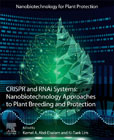
CRISPR and RNAi Systems: Nanobiotechnology Approaches to Plant Breeding and Protection
Abd-Elsalam, Kamel A.
Lim, Ki-Taek
CRISPR and RNAi Systems: Nanobiotechnology Approaches to Plant Breeding and Protection presents a complete understanding of the RNAi and CRISPR/Cas9 techniques for controlling mycotoxins, fighting plant nematodes, and detecting plant pathogens. CRISPR/Cas genome editing enables efficient targeted modification in most crops, thus promising to accelerate crop improvement. CRISPR/Cas9 can be used for management of plant insects and various plant pathogens. This book is an important reference source for both plant scientists and environmental scientists who want to understand how nanobiotechnologically-based approaches are being used to create more efficient plant protection and plant breeding systems. Plants are vulnerable to pathogens including fungi, bacteria and viruses which can cause critical problems and deficits. Crop protection by plant breeding delivers a promising solution with no obvious effect on human health or the local ecosystem. Crop improvement has been the most powerful approach for producing unique crop cultivars since domestication occurred, making possible the main innovations in feeding the globe and community development. Genome editing is one of the genetic devices that can be implemented, and disease resistance is frequently cited as the most encouraging application of CRISPR/Cas9 technology in agriculture. Shows how nanotechnology is being used as the basis for new solutions for more efficient plant breeding and plant protectionOutlines the major techniques and applications of both CRISPR and RNAi technologiesAssesses the major challenges of escalating these technologies on a mass scale INDICE: 1. CRISPR and RNAi: A Promising Tool in Plant Nanobiotechnology 2. RNAi/CRISPR based system: Targeted genome engineering for insect control 3. CRISPR/Cas9 regulations in plant science 4. Are CRISPR/Cas9 and RNAi-based new technologies to relocate crop pesticides? 5. CRISPR-Cas epigenome editing technology: improving crop resistance to pathogens 6. CRISPR System for the development of disease-resistance in horticulture crops 7. CRISPR and RNAi technology for crop improvements in the developing countries 8. CRISPR/Cas9 applications for virus resistance 9. Current Trends and Recent Progress of Genetic Engineering in Genus Phytophthora using CRISPR Systems 10. CRISPR/Cas 9 and Cas13a Systems: a promising tool for plant breeding 11. CRISPR/Cas techniques: a new method for RNA interference in cereals 12. Different ways of wheat genetic transformation for efficient genome editing 13. CRISPR-Cas for genome editing in Cotton 14. Wheat Starch via CRISPR System: Biosynthesis and Regulatory Pathways 15. Role of CRISPR/Cas system in altering phenolics and carotenoids biosynthesis for plants defense 16. Fungal Genome Editing Using CRISPR-Cas Nucleases: A New Tool for the Management of Plant Diseases 17. CRISPR-Cas systems as antimicrobial agents for agri-food pathogens. 18. CRISPR Interference System: A potential strategy to inhibit pathogenic biofilm in agri-food sector 19. Patenting Dynamics in CRISPR gene editing technologies 20. Databases and Bioinformatics Tools for Genome Editing in Plants using CRISPR/Cas and RNA interference 21. RNAi and CRISPR/Cas9 techniques for controlling mycotoxins 22. Role of Small RNA and RNAi Technology Towards Improvement of Abiotic Stress Tolerance in Plants 23. RNAi based system a new tool for insects' control 24. RNAi strategy for management of phytopathogenic fungi 25. CRISPR applications in plant bacteriology: today and future perspectives 26. RNAi-based gene silencing in plant parasitic nematodes: A road towards crop improvement 27. RNAi mediated viral disease resistance in crop plants 28. Phytoalexin biosynthesis through RNAi for disease resistance 29. Polymer and lipid-based nanoparticles to deliver RNAI and CRISPR systems 30. Inorganic Smart Nanoparticles: New Tool to Deliver CRISPR systems into Plant Cells 31. Regulatory aspects, risk assessment, and toxicity associated with RNAi and CRISPR methods 32. Gene editing in oomycetes and filamentous fungi using CRISPR-Cas technology 33. CRISPR System to enhance abiotic stress tolerance in plants
- ISBN: 978-0-12-821910-2
- Editorial: Elsevier
- Encuadernacion: Rústica
- Páginas: 702
- Fecha Publicación: 01/03/2021
- Nº Volúmenes: 1
- Idioma: Inglés
